Through the eyes of an educator: Zanzibar, Tanzania
Travel has been an eye opener for me. It’s left me speechless, brought me to tears, amazed me, enraged me, educated me and forever changed me. There have been moments of sheer joy and stories of the unthinkable. Learning through travel allows the world to be your classroom and its people, your teacher. History as told through a variety of people often has a different feel than one consistently told in the same voice. Books can take you on wild adventures and transport readers to a different time, but there’s something to be said about walking in the footsteps of history. Talking to a survivor of the Cambodian genocide sends different shivers down your spine than would be available through a textbook. Standing in the Serengeti interacting with Maasai warriors wields a magic all its own. Even wandering the streets of your own city provides a three dimensional version of history that touches your senses and pulls in all facets of Bloom’s taxonomy rather than just meeting one or if you’re lucky, two.
Today’s world is filled with fast paced tweets and Instagram feeds and emails that pile up in your inbox at all hours of the night. Technology flies past even itself and it’s difficult for school systems to keep up with the constant developments. The written word is vital yet so much of learning goes far beyond classroom walls. Nowhere in a traditional textbook do you find personal space details and how it varies from one country to another. It’s not often that you find information pertaining to how to utilize public transport or what hand signs can be peaceful in one place and land you in jail in another. The world has much to offer if only we’d get out and see it. Zanzibar, Tanzania offers all of this and so very much more.
In August of 2012, my husband and I spent two weeks in East Africa. One of the largest, poorest and countries with the most tourism in Africa, the people and landscape of Tanzania affected us more than we expected. We spent time on the spice island of Zanzibar and on safari through the Serengeti and Ngorongoro Crater, finally crossing the border into Kenya. The learning began even before we got there, with research into vaccinations, anti-malaria medications, and waiting out the visa process and then continued moments into landing at the airport in Dar Es Salaam.
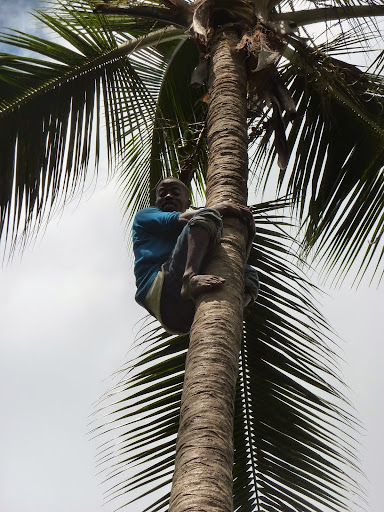
Jambo! Climbing a tree at the plantation
As with anywhere in the world, shared language can express communication and breed relationships. Quickly ascertaining that Jambo is hello, Karibu is welcome, and Asante or Asante San means thank you, we were able to exchange US dollars for Tanzanian shillings and were ready for an adventure into another part of Africa. Tanzania, one of the world’s poorest nations, is still in the midst of economic flux. Throughout the nation, and especially in Zanzibar, the gap between the rich and poor is blatantly visible. Poverty is noticeable on the streets, along with businesses opening, children smiling, and people just trying to make a living.
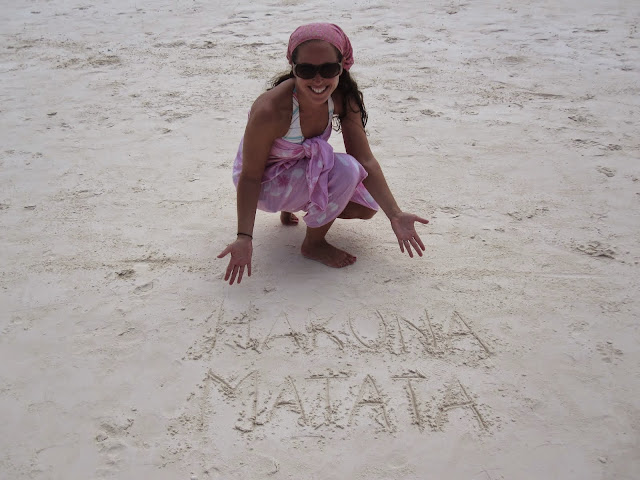
Zanzibar has a large Muslim population and the center of Stone town is particularly observant. We arrived just as Ramadan had ended, and the entire island was in the midst of celebrations. Wanting a taste of the festivities, we went to a bustling night market in the center of town. This large park area was heaving with people and felt as vibrant as an Asian night street market with a Middle Eastern edge. Beautifully adorned women holding the hands of their children dressed in their holiday best lined the paths, eating all sorts of treats. The smell of open flamed barbecues mixing with raw sugarcane filled the air as people lined by carts to taste this sweet juice hand pressed in front of their eyes. Holding hands so as not to lose each other, we came to a stand with which our tour guides were familiar. Precooked already, the food, ready to be warmed again over the open flame, covered the table from end to end. Everything was loud and fast-if you blinked you would most certainly miss something. This park was alive with the beautiful chaos of a street fair, and prices were negotiable. On sticks there were beef, chicken, tuna, mahi mahi, calamari, and prawns that Rashi (who owned the stand with Mr. Happy) said came ‘with or without the uniform’. Finishing out the spread was naan bread, chips, potato, falafel, octopus, hummus, and more fish visible under the small lamps of the table. Senses were assaulted from every angle and people filled the entire park. I think my favourite stall to see was the Zanzibar pizza. Started with a dollop of pure ghee that danced as it hit the flattop grill, this dough filled with nutella and bananas was wrapped in a square shape and cooked oozing delicious goodness everywhere. There are many lessons found amidst a market and this one not only included cuisine, cultures, and maths, but religious celebrations as well.
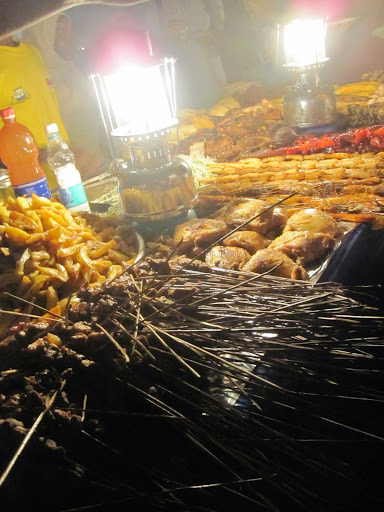
Zanzibar night market
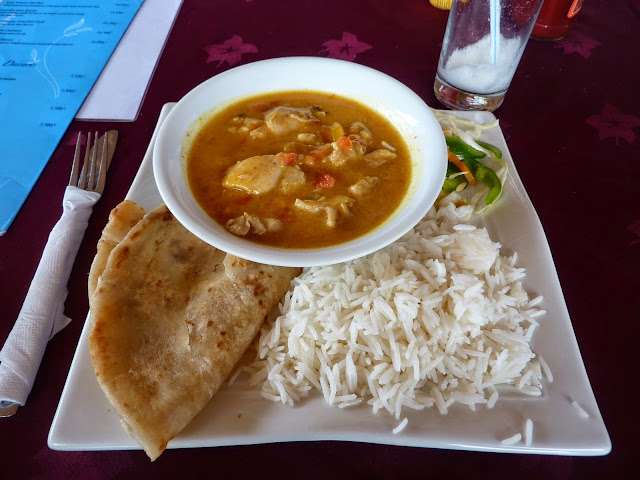
Flavorful dishes in Zanzibar
The crystal clear blue of the Indian Ocean and the white soft sand attracts many visitors. There’s much to be learned in and around this immense body of water. Known for diving and snorkeling and learning about sea creatures, travelers can do more than relax in the sand. Life in Zanzibar is cultural diffusion in living color. Travelers and locals are from many parts of the world. Food is a blend of African and Indian flavors, utilizing many of the spices grown locally. Chapati, naan, rice dishes, and curries are readily available along with African spice rubs and an immense supply of seafood. Whether it's anthropology, sociology, science, or language, informal learning is omnipresent. Zanzibar is far more than beautiful beaches and flavor filled night markets.
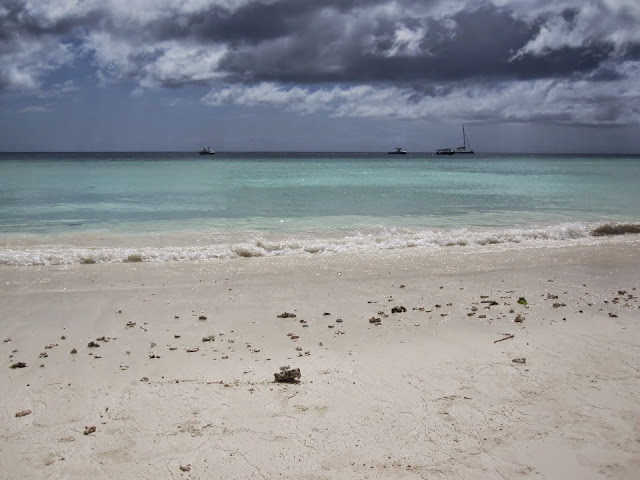
Zanzibar's natural beauty
Known as the spice island, it holds the secrets of plants and the benefits of herbs. At a spice plantation, Salum, our local guide, introduced us to varieties of plants, trees, and incredible methods we’d never before seen. We learned the powers of nutmeg and cinnamon bark, the medicinal features of lemongrass and turmeric, the magic of ginger, and witnessed the twisting vines of fragrant vanilla beans. Salum taught us of a tea for seasickness or upset stomach that would consist of ginger, cinnamon, and cardamom. He showed us the Peri-Peri peppers and shared how their seeds can attach to the appendix over time if you eat too many. We watched in awe as a barefooted climber hoisted himself up a coconut palm tree with nothing more than a small plastic loop on his feet and his own intertwined fingers. The best part was that he sang a song at the top to alert others that someone was up the tree and that coconuts would soon rain from above. Botany, herbology, holistic medicine, and agriculture were just a few of the lessons we found in the plantation.
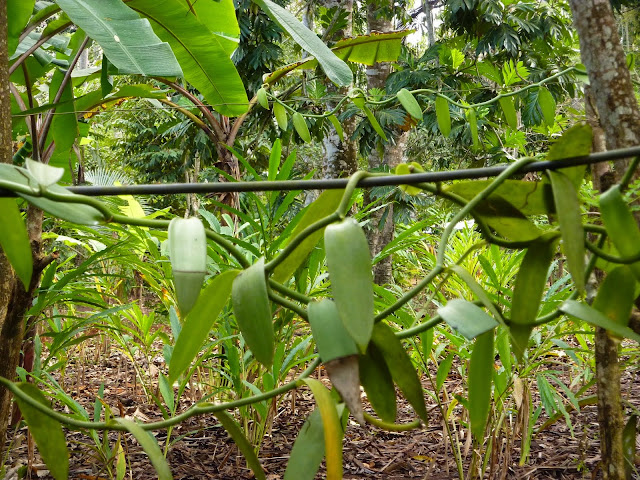
twisting vanilla bean at the spice plantation
Sadly, there are many dark marks throughout history. Although today Zanzibar is known more for its beauty and spices than anything else, at one time the island was part of the East African slave trade. St. Monica’s Hostel and Anglican Church in Stone town is on the site of the former East African Slave Market. History is palpable and stories legendary including that of David Livingstone’s involvement in the end of the slave market. His mark was so great and that of Africa’s on him, that when he died, he wanted a part of his body to be buried in Africa. His heart remained and the rest of him was flown to England. There are many tributes to his work seen in this building and its surrounds. Special to this area is the cross made from the Jojoba tree and the upside down pillars in the back of the church formed due to a mix up when the lead engineer was on holiday in Europe. There’s a monument that memorializes the slaves and makes clear the markings of the slave trade on this tiny island. The statue visually depicts people being placed in the ground in chains-it’s difficult to stomach, but tells the truth of the time. If you’re interested, you can go into the slave quarters to witness the settings of some of the atrocities done to human beings. You walk through tiny, cold, and stuffy concrete hallways. Standing in a tiny cement room, even I had difficulty (and I’m only 4’11). There’s a pathway or trough where slaves would relieve themselves. Seventy-five women and children would be in one small cell, while fifty men would be in another directly across the way. With chains around their necks and hands most likely cuffed, this minimally lit cement room was complete torture.
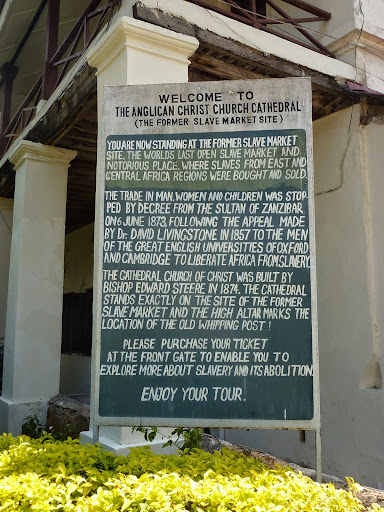
Former slave market, Zanzibar
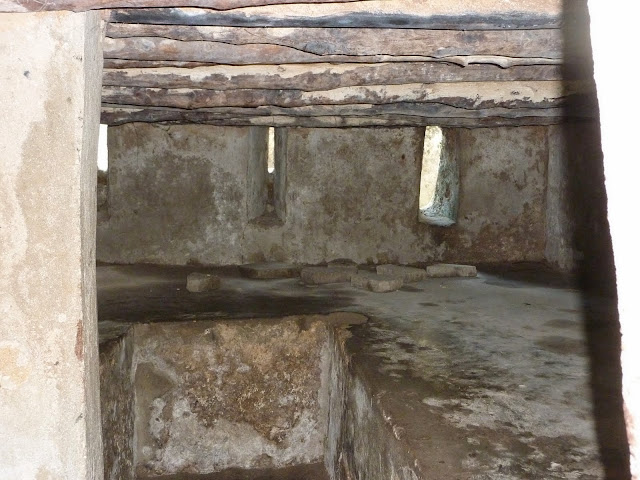
slave chambers at the slave market
Like many other small islands, Zanzibar provides more than sand and water. Religious observance is witnessed in Stone town, where women are encouraged to cover shoulders and knees in the city center. The blending of cultures is tasted through foods, played in cricket matches, heard in dialects of English, Swahili, and assorted other languages, and felt in the presence of people from around the world. I learned at the night market. I learned at the spice plantation, and I even learned while sitting on the beach wrapped in a locally made sarong. There is more than one way to learn - and it happened for me while visiting the beautiful spice island of Zanzibar, Tanzania.

Sunset from the Africa House, Zanzibar
Stacey Ebert is a traveler at heart who met her Australian-born husband while on a trip in New Zealand. Stacey was an extracurricular advisor and taught history in a Long Island public high school for over fifteen years, enjoying both the formal and informal educational practices. After a one year 'round the world honeymoon, travel and its many gifts changed her perspective. She has since left the educational world to focus on writing and travel. She is energetic and enthusiastic about long term travel, finding what makes you happy and making the leap. In her spare time she is an event planner, yogi, dark chocolate lover, and spends as much time as possible with her toes in the sand. Check out her website at thegiftoftravel.wordpress.com for more of her travel musings.
All photos courtesy and copyright Stacey Ebert
There is more than one way to learn and it happened for me while visiting the beautiful spice island of Zanzibar, Tanzania.
Posted by: Stacey Ebert
-

- Log in to post comments




















